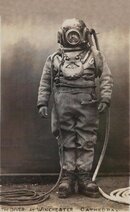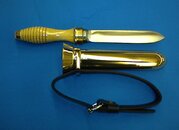I had the opportunity to dive the MK 5. It leaked like a sieve and they said that once the water got past your shins to surface. If you fell over the water would rush to the helmet and drown you. Heard a few funny stories of arc welding with exposed wires.
You are using an out of date browser. It may not display this or other websites correctly.
You should upgrade or use an alternative browser.
You should upgrade or use an alternative browser.
What do you call this gear?
- Thread starter Akimbo
- Start date
Please register or login
Welcome to ScubaBoard, the world's largest scuba diving community. Registration is not required to read the forums, but we encourage you to join. Joining has its benefits and enables you to participate in the discussions.
Benefits of registering include
- Ability to post and comment on topics and discussions.
- A Free photo gallery to share your dive photos with the world.
- You can make this box go away
I had the opportunity to dive the MK 5. It leaked like a sieve and they said that once the water got past your shins to surface. If you fell over the water would rush to the helmet and drown you...
Thats not exactly right, unless your air supply also fails at the same time. I knew a few old-timers that would force their feet above their heads on the downline at the end of the dive to blow the water out of the exhaust valve. Trust me; nobody wants to carry all that water up the ladder. This casual attitude about maintaining suits (water-tight integrity) was/is a lot more common in warm water than cold.
The photo in the OP is of a Navy diver training in the Helium Hat. His suit is inflated so the tenders can do a soap test to fix expensive Helium leaks. Deep-sea drysuits definitely can be water-tight, it just takes a lot of patching.
I would call that the don't eat beans suit. Lol cool picture though and I'd love to experiance a dive in one, however I can't afford a dry suit yet so a copper spun helium hat may take a few decades....
I would call that the don't eat beans suit...
You have no idea how insightful that observation is. The training barge in Second Class Diving School barge had some contaminated potable water tanks when I was there. Everyone's guts were affected; students and instructors. More than one guy had to take a fire hose to the inside of their suit. Good thing the compressors were big and the ventilation rates could be cranked up.
Belzelbub
Contributor
I know it's not entirely accurate. But in my head, when I see that suit, I immediately think of an old sponge diver suit. Just north of me is Tarpon Springs, FL. This city is the sponge diving mecca, at least around here. So, when I was growing up, I saw these suits associated with sponge diving, so that's the first thing I think of.
I know it's not entirely accurate. But in my head, when I see that suit, I immediately think of an old sponge diver suit. Just north of me is Tarpon Springs, FL...
Actually, it is quite accurate. The sponge divers in Florida and Greece tended to favor the Seibe-Gorman style of hats with weights that hung off the breast plate. The Navy Mark V used a leather weight belt, but there isnt that much functional difference between any of them. Several European manufactures made hats in this style. Here is an image of a Seibe-Gorman:
Attachments
Just curious. What phrase do recreational Scuba divers use to describe divers like this?
View attachment 134807
I was thinking more like “Heavy Gear” or “Deep Sea” as opposed to nuts, dinosaur, or historic.For those interested, this is a US Navy Mark V Helium Hat.
BLOODY HARD WORK is what comes to mind immediately, mate!
Last edited:
scjoe
Contributor
Actually, it is quite accurate. The sponge divers in Florida and Greece tended to favor the Seibe-Gorman style of hats with weights that hung off the breast plate. The Navy Mark V used a leather weight belt, but there isn’t that much functional difference between any of them. Several European manufactures made hats in this style. Here is an image of a Seibe-Gorman:
I see that the diver has one of the old DESCO Navy knifes. Are those knives still in use? How well does a leather weight belt hold up over time?
I see that the diver has one of the old DESCO Navy knifes. Are those knives still in use? How well does a leather weight belt hold up over time?
There was a lot of leather in the old deep sea rigs, including gaskets. It held up surprisingly well as long as it was maintained by coating it with neatsfoot oil.
Primitive as it may sound, leather gaskets do have one advantage -- they aren't turned to goo by petroleum products. Rubber gaskets would have been a huge problem during the Pearl Harbor salvage work right after the attack. There was 6" of bunker fuel oil floating in the harbor for months that the divers had to work through. Hoses are much harder rubber and more resistant to chemical attack.
That photo above is from the 1906 time-frame during work on the Winchester Cathedral. I seem to remember that the Seibe-Gorman Company was somehow involved with that project. I "suspect" that the knife was the current Seibe-Gorman model at the time and the US Navy copied the design, which is now still made by Desco. The newer knife design from Seibe I have seen uses a flat bronze sheath with a friction retainer.
I never actually saw one of these knives while I was in the Navy (early 1970s). I understand they were all snagged by senior people or used for comshaw (Navy slang for unofficial trading, especially for higher priorities like getting supplies or repairs faster).
Here is an image of Desco's screw-in knife. That is a leather strap on the sheath.
Attachments
Last edited:
Similar threads
- Replies
- 13
- Views
- 574
- Replies
- 32
- Views
- 1,977
- Replies
- 22
- Views
- 1,304
- Replies
- 39
- Views
- 3,222





